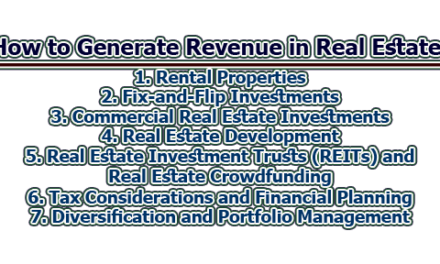Calculating Return on Investments (ROI) in Real Estate:
Calculating Return on Investments (ROI) in real estate is a crucial aspect of evaluating the profitability and performance of an investment property. ROI provides investors with a comprehensive understanding of the financial gains or losses resulting from their real estate ventures. Return on Investment (ROI) is a financial metric used to measure the profitability of an investment relative to its cost. In real estate, ROI determines the return generated from an investment property over a specific period, considering both income and expenses associated with the property. ROI is typically expressed as a percentage or ratio. In this article, we will delve into the details of Calculating Return on Investments (ROI) in real estate, covering various components, formulas, and considerations.
Components of ROI Calculation:
Calculating the Return on Investments (ROI) in real estate involves considering several components to determine the profitability and performance of an investment property. The primary elements of ROI calculation include the initial investment cost, net income generated, and holding period. Additionally, accounting for expenses and financing costs is essential for a comprehensive ROI analysis. Let’s delve into each component in detail:
A. Initial Investment Cost: The initial investment cost refers to the total amount of money invested in acquiring the property. It includes the purchase price of the property as well as any associated costs, such as closing costs, legal fees, inspection fees, and renovation or repair expenses. The initial investment cost is crucial as it forms the basis for calculating the return on that investment.
B. Net Income Generated: Net income is a critical component of ROI calculation, as it represents the revenue generated by the investment property after deducting all expenses. Net income includes the rental income received from tenants, minus the various costs associated with property ownership and operation. These expenses typically include property taxes, insurance, maintenance and repair costs, property management fees, vacancy losses, and utilities.
To calculate net income, subtract the total expenses from the rental income over a specific period, such as a year. It is important to ensure that all relevant expenses are considered to obtain an accurate representation of the property’s financial performance.
C. Holding Period: The holding period refers to the length of time an investor holds the investment property before selling it. It is typically measured in years. The holding period is crucial in ROI calculations, as it determines the duration over which the return on the investment is assessed. The longer the holding period, the more time there is for the property to generate income and potentially appreciate in value.
D. Expenses: Accounting for expenses is vital for an accurate ROI calculation. These expenses can be broadly categorized into two types: operating expenses and capital expenses.
- Operating Expenses: Operating expenses include costs incurred for the day-to-day operation and maintenance of the investment property. Examples of operating expenses include property management fees, property taxes, insurance premiums, repairs and maintenance, utilities, advertising, and legal and accounting fees. These expenses are subtracted from the rental income to determine the net operating income.
- Capital Expenses: Capital expenses refer to significant expenditures incurred for the improvement, renovation, or replacement of property components that increase its value or extend its useful life. These expenses are not deducted from the rental income directly but are accounted for separately. Capital expenses can include major repairs, renovations, upgrades, or the replacement of essential systems like HVAC or roofing. These costs are typically spread over the property’s useful life and accounted for through depreciation.
E. Financing Costs: Financing costs are relevant if the investment property is financed through a mortgage or other forms of financing. These costs include interest payments, loan origination fees, points, and other financing charges. When calculating ROI, it is essential to deduct these financing costs from the net income to obtain a more accurate representation of the return on the cash invested.
F. ROI Formula: Once all the components are considered, ROI can be calculated using the following formula:
ROI = (Net Income – Total Expenses) / Initial Investment Cost * 100
The resulting ROI is expressed as a percentage and represents the return on the investment relative to the initial investment cost.
By carefully considering these components and conducting a thorough analysis, real estate investors can calculate ROI accurately and gain valuable insights into the profitability and performance of their investment properties.
Types of Real Estate ROI:
There are multiple variations of ROI commonly used in real estate investment analysis. The most frequently utilized types include Gross Rental Yield, Net Rental Yield, Cash-on-Cash Return, and Cap Rate. Each type emphasizes different aspects of the investment property’s financial performance.
i. Gross Rental Yield: Gross Rental Yield measures the return on investment before accounting for any expenses, except for the property’s purchase price. It is calculated by dividing the annual rental income by the property’s purchase price and multiplying it by 100 to express it as a percentage.
Gross Rental Yield = (Annual Rental Income / Property Purchase Price) * 100
For example, if an investment property generates an annual rental income of $30,000 and was purchased for $400,000, the gross rental yield would be:
Gross Rental Yield = ($30,000 / $400,000) * 100 = 7.5%
ii. Net Rental Yield: Net Rental Yield provides a more accurate representation of the property’s profitability by incorporating various expenses associated with property ownership. These expenses typically include property management fees, property taxes, insurance, maintenance costs, and vacancy losses. The formula for calculating net rental yield is as follows:
Net Rental Yield = (Annual Rental Income – Annual Expenses) / Property Purchase Price * 100
For instance, if an investment property generates an annual rental income of $30,000 and incurs $8,000 in annual expenses while being purchased for $400,000, the net rental yield would be:
Net Rental Yield = ($30,000 – $8,000) / $400,000 * 100 = 5.5%
iii. Cash-on-Cash Return: Cash-on-Cash Return measures the return on the actual cash invested in the property, considering the financing used for the purchase. It helps investors assess the return relative to the cash invested rather than the overall property value. The formula for calculating cash-on-cash return is as follows:
Cash-on-Cash Return = (Annual Net Operating Income / Total Cash Investment) * 100
The net operating income is the property’s annual income after deducting operating expenses but before considering financing costs. The total cash investment includes the down payment, closing costs, and any renovation expenses related to the property.
For example, if an investor purchases a property for $500,000, makes a down payment of $100,000, and incurs $20,000 in closing costs and renovation expenses, with an annual net operating income of $30,000, the cash-on-cash return would be:
Cash-on-Cash Return = ($30,000 / ($100,000 + $20,000)) * 100 = 27.27%
iv. Cap Rate (Capitalization Rate): Cap Rate is another important metric used to assess the profitability of a real estate investment. It indicates the expected rate of return on an investment property based on its net operating income and market value. The formula for calculating the cap rate is as follows:
Cap Rate = (Net Operating Income / Property Value) * 100
For instance, if a property generates an annual net operating income of $50,000 and has an estimated value of $1,000,000, the cap rate would be:
Cap Rate = ($50,000 / $1,000,000) * 100 = 5%
Cap Rate is particularly useful when comparing multiple investment properties or evaluating the potential return on an investment property based on its market value.
Factors Affecting ROI Calculation:
Calculating the Return on Investments (ROI) in real estate requires considering various factors that can significantly impact the financial performance and profitability of an investment property. These factors should be carefully assessed to ensure an accurate and comprehensive ROI calculation. Let’s explore the key factors that affect ROI in real estate:
- Rental Income: Rental income plays a crucial role in the ROI calculation. The amount of rental income generated by an investment property is influenced by several factors, including market conditions, property location, property type, amenities, demand for rental properties in the area, and rental rates in the local market. Higher rental income positively affects the ROI by increasing the cash flow and overall return on investment.
- Property Expenses: Expenses associated with owning and operating a real estate investment property directly impact ROI. These expenses can be divided into two categories: operating expenses and capital expenses.
- Operating Expenses: Operating expenses include the day-to-day costs of property ownership and management. They typically include property taxes, insurance premiums, property management fees, repairs and maintenance, utilities, advertising, legal and accounting fees, and other costs related to the property’s ongoing operation. Higher operating expenses can reduce the net income and subsequently lower the ROI.
- Capital Expenses: Capital expenses are significant expenditures made for the improvement, renovation, or replacement of property components that increase its value or extend its useful life. These expenses are typically incurred less frequently but can have a substantial impact on ROI. Examples of capital expenses include major repairs, renovations, upgrades, or the replacement of essential systems like HVAC or roofing. It’s important to account for these expenses separately and spread them over the property’s useful life through depreciation.
- Financing Costs: If the investment property is financed through a mortgage or other forms of financing, financing costs must be considered in ROI calculations. These costs include interest payments, loan origination fees, points, and other financing charges. Financing costs directly impact the cash flow and overall profitability of the investment. Deducting these expenses from the net income provides a more accurate representation of the return on the cash invested.
- Property Appreciation: Property appreciation refers to the increase in the value of the investment property over time. It is an important factor that affects ROI, especially in long-term investments. Property appreciation can significantly enhance the overall return on investment when the property is sold or refinanced. Factors influencing property appreciation include supply and demand dynamics in the local real estate market, economic conditions, infrastructure development, and neighborhood growth. Higher property appreciation can positively impact the ROI.
- Depreciation: Depreciation is a non-cash expense that reflects the wear and tear, deterioration, or obsolescence of the investment property over time. While it doesn’t directly impact cash flow, it is an essential factor to consider for tax purposes. Depreciation allows investors to deduct a portion of the property’s value each year, reducing taxable income. This tax benefit can indirectly improve the ROI by reducing the investor’s tax liability.
- Market Conditions: Market conditions play a significant role in the ROI calculation. Factors such as the overall health of the economy, real estate market trends, interest rates, population growth, job opportunities, and local demand for rental properties can all influence rental income, property appreciation, and vacancy rates. Positive market conditions can contribute to higher rental income and property values, thereby enhancing the ROI.
- Vacancy and Tenant Turnover: Vacancy and tenant turnover has a direct impact on rental income and cash flow. High vacancy rates and frequent tenant turnover can lead to increased expenses related to marketing, advertising, and preparing the property for new tenants. It is crucial to account for potential vacancy periods and turnover costs when calculating ROI to ensure a realistic representation of the investment’s financial performance.
- Management Efficiency: The efficiency of property management can significantly impact ROI. Effective property management ensures that the property is well-maintained, tenants are satisfied, vacancies are minimized, and rental income is maximized. A professional and efficient property management team can help streamline operations, reduce expenses, and improve tenant retention, ultimately contributing to a higher ROI.
- Tax Considerations: Tax implications can have a substantial impact on ROI. It’s important to understand the tax laws and regulations related to real estate investments in the specific jurisdiction. Factors such as property taxes, income taxes, capital gains taxes, and tax deductions (including depreciation) can influence the overall profitability of the investment. Optimizing tax strategies and taking advantage of available tax benefits can positively impact the ROI.
- Economic Factors: Overall economic factors, including inflation, interest rates, and the general economic outlook, can affect ROI. Inflation can impact both rental income and property value, potentially increasing rental rates and property appreciation. Interest rates, on the other hand, can impact financing costs and mortgage payments, influencing the cash flow and overall ROI. Evaluating the economic climate and its potential impact on the investment is crucial for accurate ROI calculations.
- Market Demand and Competition: Understanding market demand and competition in the local real estate market is essential. Factors such as population growth, job opportunities, and lifestyle trends can influence rental demand and rental rates. A high-demand market with limited competition can lead to higher rental income and potentially enhance the ROI. Conversely, oversaturated markets or declining demand may negatively impact rental income and ROI.
- Property Management Strategy: The chosen property management strategy can affect ROI. Different investment strategies, such as long-term rentals, vacation rentals, or property flipping, have varying risk profiles, return expectations, and management requirements. Each strategy has its own unique factors that can influence ROI, including rental demand, occupancy rates, seasonality (in the case of vacation rentals), and property appreciation potential.
- Market Liquidity: Market liquidity refers to the ease with which an investment property can be bought or sold. It is an important factor to consider as it impacts the ability to exit an investment and realize the ROI. Factors that affect market liquidity include market conditions, property type, location, and demand. Illiquid markets can make it challenging to sell a property quickly, potentially affecting the ROI calculation.
By considering these factors and conducting thorough due diligence, real estate investors can obtain a more accurate and comprehensive understanding of the potential ROI of an investment property. It is crucial to evaluate each factor in conjunction with others and analyze their combined impact on the investment’s financial performance and profitability.
Accounting for Expenses:
To calculate a realistic ROI, it is essential to account for various expenses associated with owning and operating an investment property. These expenses may include property taxes, insurance, maintenance and repair costs, property management fees, vacancy losses, and utilities. By subtracting these expenses from the rental income, you can determine the net income generated by the property.
Accounting for Financing Costs:
When financing is involved in a real estate investment, it is crucial to consider the costs associated with it, such as interest payments, loan origination fees, and other financing charges. These costs directly impact the cash flow and overall profitability of the investment. It is necessary to deduct these financing costs from the net income to obtain a more accurate ROI calculation.
Using ROI to Evaluate Real Estate Investments:
ROI serves as a valuable tool for evaluating and comparing real estate investments. By calculating and comparing the ROI of different properties, investors can identify the most profitable opportunities. Additionally, ROI analysis allows investors to assess the performance of their existing properties and make informed decisions about buying, holding, or selling properties.
When using ROI to evaluate real estate investments, it is essential to consider other factors alongside ROI, such as market conditions, location, potential for property appreciation, rental demand, and future development plans. ROI should be viewed as one piece of the puzzle and not the sole determinant of an investment’s viability.
ROI Limitations and Considerations:
While ROI is a valuable metric, it has certain limitations that should be taken into account. First, ROI calculations are based on estimates and projections, which are subject to uncertainty and changes in market conditions. Second, ROI does not consider non-financial factors such as personal enjoyment of the property or potential tax benefits. Third, ROI does not account for the time and effort invested in managing the property. Lastly, ROI does not reflect the potential risks associated with real estate investments, such as economic downturns or unexpected expenses.
It is crucial to conduct thorough due diligence, consider multiple financial metrics, and seek professional advice before making real estate investment decisions solely based on ROI calculations.
In conclusion, calculating ROI in real estate is a vital tool for investors to assess the profitability and performance of their investment properties. By utilizing the appropriate formulas and considering various factors, investors can make informed decisions, maximize their returns, and build a successful real estate portfolio.
References:
- Brueggeman, W., & Fisher, J. (2017). Real estate finance and investments. McGraw-Hill Education.
- Geltner, D., Miller, N. G., Clayton, J., & Eichholtz, P. M. (2018). Commercial real estate analysis and investments. Cengage Learning.
- Linneman, P. (2014). Real estate finance and investments: Risks and opportunities. Prentice Hall.
- Gray, P., Peterson, J., & Massad, K. (2018). Real estate market analysis: Methods and case studies. Routledge.
- Eldred, G. (2016). The beginner’s guide to real estate investing. BiggerPockets.
- Cheng, C. L., & Longhofer, S. D. (2016). Real estate principles: A value approach. McGraw-Hill Education.
- Gallinelli, F. (2015). What Every Real Estate Investor Needs to Know About Cash Flow… And 36 Other Key Financial Measures. McGraw-Hill Education.
- Institute of Real Estate Management (IREM). (2019). Real Estate Investment: A Strategic Approach. Institute of Real Estate Management.
- Shilling, J. D., & Siow, C. K. (2015). Real estate economics. The Journal of Economic Perspectives, 29(4), 217-238.
- Tintelnot, F. (2019). Real Estate Investments and Business Cycles. Journal of Monetary Economics, 104, 109-124.

Library Lecturer at Nurul Amin Degree College










